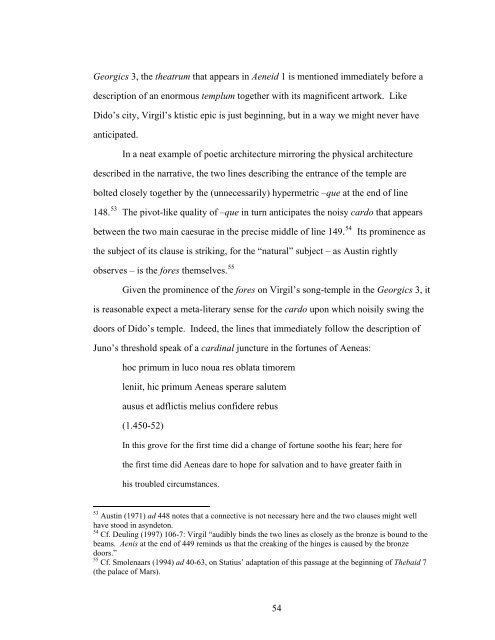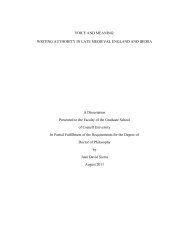Dissertation FINAL2.pdf - Cornell University
Dissertation FINAL2.pdf - Cornell University
Dissertation FINAL2.pdf - Cornell University
Create successful ePaper yourself
Turn your PDF publications into a flip-book with our unique Google optimized e-Paper software.
Georgics 3, the theatrum that appears in Aeneid 1 is mentioned immediately before a<br />
description of an enormous templum together with its magnificent artwork. Like<br />
Dido’s city, Virgil’s ktistic epic is just beginning, but in a way we might never have<br />
anticipated.<br />
In a neat example of poetic architecture mirroring the physical architecture<br />
described in the narrative, the two lines describing the entrance of the temple are<br />
bolted closely together by the (unnecessarily) hypermetric –que at the end of line<br />
148. 53 The pivot-like quality of –que in turn anticipates the noisy cardo that appears<br />
between the two main caesurae in the precise middle of line 149. 54<br />
Its prominence as<br />
the subject of its clause is striking, for the “natural” subject – as Austin rightly<br />
observes – is the fores themselves. 55<br />
Given the prominence of the fores on Virgil’s song-temple in the Georgics 3, it<br />
is reasonable expect a meta-literary sense for the cardo upon which noisily swing the<br />
doors of Dido’s temple. Indeed, the lines that immediately follow the description of<br />
Juno’s threshold speak of a cardinal juncture in the fortunes of Aeneas:<br />
hoc primum in luco noua res oblata timorem<br />
leniit, hic primum Aeneas sperare salutem<br />
ausus et adflictis melius confidere rebus<br />
(1.450-52)<br />
In this grove for the first time did a change of fortune soothe his fear; here for<br />
the first time did Aeneas dare to hope for salvation and to have greater faith in<br />
his troubled circumstances.<br />
53 Austin (1971) ad 448 notes that a connective is not necessary here and the two clauses might well<br />
have stood in asyndeton.<br />
54 Cf. Deuling (1997) 106-7: Virgil “audibly binds the two lines as closely as the bronze is bound to the<br />
beams. Aenis at the end of 449 reminds us that the creaking of the hinges is caused by the bronze<br />
doors.”<br />
55 Cf. Smolenaars (1994) ad 40-63, on Statius’ adaptation of this passage at the beginning of Thebaid 7<br />
(the palace of Mars).<br />
54
















